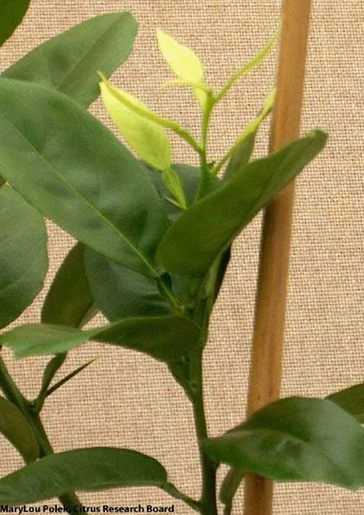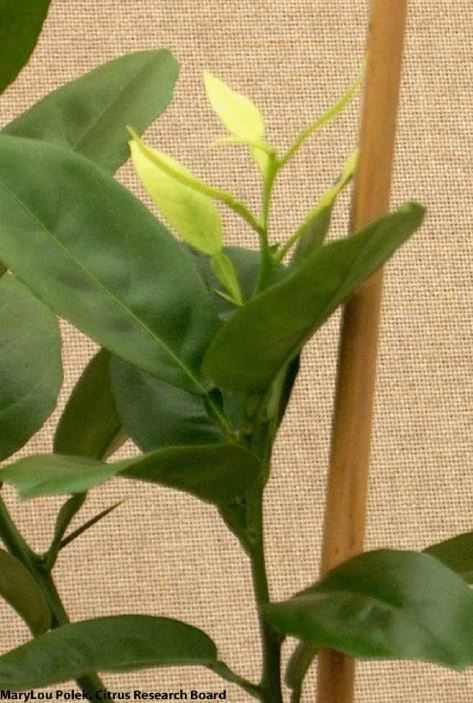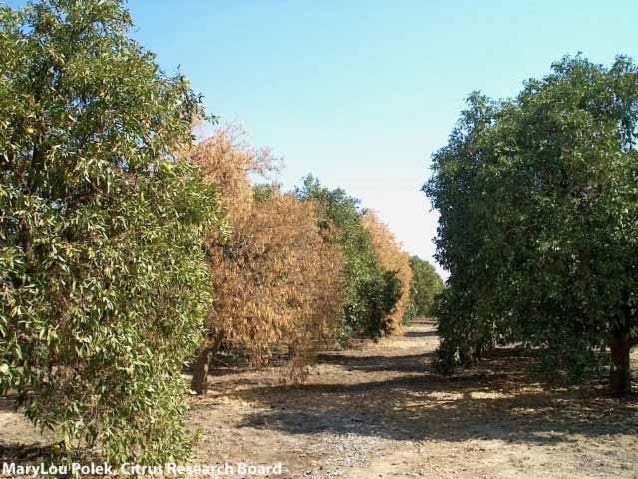Citrus tristeza virus Pest Profile
Pest Profile

Description
Citrus tristeza (CTV) is a virus that causes various diseases in citrus plants. CTV diseases have multiple common names around the world. The most well-known are quick decline, tristeza, citrus seedling yellows, grapefruit stem pitting, lime dieback, and yellow dwarf. CTV is a state regulated A-rated plant pest as defined in Section 3407 of the California Food and Agricultural Code.
History
In the nineteenth century, importation of citrus commodities occurred only as seed. Over time as logistics improved, citrus commodities were exported and imported globally as plants or budwood, easily spreading CTV to new regions.
In California’s San Joaquin Valley, there are three pest control districts which are monitored by the Central California Tristeza Eradication Agency (CCTEA). CCTEA gathers information for mapping, monitoring CTV titer, collecting flush samples for testing to capture field isolates, and biological indexing.
Distribution
CTV exists in every citrus producing area of the world from Asia, Africa, Europe, Oceania, and the Americas.
California is divided into three Tristeza zoning areas categorized as regulated, quarantined, and suppressive. Regulated areas are closely monitored to ensure appropriate measures and practices are being followed to detect CTV and prevent the spread of CTV into the area. Quarantine areas indicate CTV is present and no significant efforts to control or suppress the virus are conducted. Areas categorized as suppressive means CTV has been detected. Suppressive areas have active control or suppression programs in place to detect and eradicate the disease.
Hosts
CTV has a high infection rate in almost all citrus varieties and those within the citrus family, Rutaceae. The most susceptible citrus types affected by this pathogen are sour orange and acidic limes. Varieties grafted from sour orange rootstock are at great risk. Trifoliate orange and mandarin varieties are typically more tristeza tolerant.
Symptoms
The most common visual signs of CTV are seedling yellows, stem pitting, and quick decline. The fruit on the tree begins to wither and or produce low yields of fruit. The leaves will show clearing of the veins, cupping, chlorotic leaf flecking, and corky veins. Symptoms can appear like root problems, such as thinning of foliage, dwarfing, and tree collapse. CTV can also appear as ropey or bumpy areas on the trunk of the tree. The virus causes the phloem cells to die. When this happens, carbohydrates from the leaves cannot reach the roots, and nutrients and water from the roots cannot reach the leaves.
Several species of aphids contribute to the spread of CTV. Melon aphids (Aphis gossypi) are widespread and the most significant vectors in California. Fortunately, California does not have the brown citrus aphid, Toxoptera citricida, which is one of the world’s most serious pests of citrus and is even more of a threat to citrus because of its efficient transmission of CTV. Planting infected trees introduces the virus to new sites. Aphids can transmit CTV within 24 hours of first acquiring the virus. As they move to new trees, they spread the virus with feeding. CTV is not transmissible by seed.
There are many strains of CTV and new strains continue to evolve. Citrus trees infected with some strains of CTV will readily show severe symptoms, while other strains are mild and produce no symptoms or can take several years for symptoms to occur. It is rare for symptoms to occur in areas of the tree that are fully developed at time of infection.

(Photo credit: Mary Lou Polek)

(Photo credit: UF/IFAS Citrus Extension: Citrus Tristeza Virus (ufl.edu))

(Photo credit: Mary Lou Polek)
Damage and Economic Importance
CTV has killed millions of citrus trees worldwide and is an economic threat to the multibilliondollar California citrus industry. The CTV epidemic in Southern California in the 1930s-40s made many growers relocate to the central and inland regions of the state. The virus is destructive to both commercially grown and residential citrus trees. To help detect and prevent the spread of CTV, both federal and local governments have established operational guidelines that require certification of budwood and citrus plant distribution through certified nurseries.
In California, several restrictions, ranging from permits for propagation, movement of citrus commodities, testing, and pesticide treatments of citrus, are in place in an effort to protect the citrus industry from pests and disease. A list of restrictions can be found on the California Code of Regulations webpage.
References
- About The District. Central California Tristeza Eradication Agency. (n.d.).
https://www.cctea.org/about-the-district. - Barnier, J., Grafton-Cardwell, B., Polek, M. (2010). Citrus tristeza virus (CTV): then and now. Citrograph 1:16-23.
- CABI/EPPO. 2010. Citrus tristeza virus. [Distribution map]. Distribution maps of plant diseases, No. April. Wallingford, UK: CABI, Map 289 (Edition 7).
- Chagas, M. (n.d.). Virus Particles [Photograph].
https://www.cabi.org/isc/datasheet/16705 - Dawson, W. O., Garnsey, S. M., Tatineni, S., Folimonova, S. Y., Harper, S. J., & Gowda, S. Citrus tristeza virus-host interactions. Frontiers (2013).
https://www.frontiersin.org/articles/10.3389/fmicb.2013.00088/full. - Folimonova, S. Y. (2020). Citrus tristeza virus: A large RNA virus with complex biology turned into a valuable tool for crop protection. Journals.Plos.Org.
https://journals.plos.org/plospathogens/article?id=10.1371/journal.ppat.1008416 - California Code of Regulations. (n.d.).
https://govt.westlaw.com/calregs/Document/IDC5DB970325E11E19287987FEBCE67D4?viewTy pe=FullText&originationContext=documenttoc&transitionType=DocumentItem&contextData= %28sc.Default%29 - Yokomi, R.K., &Oldfield, G.N., (1991). Seasonal fluctuations of alate aphid activity in California citrus groves. In International Organization of Citrus Virologists Conference Proceedings (19572010) (Vol. 11, No. 11).
